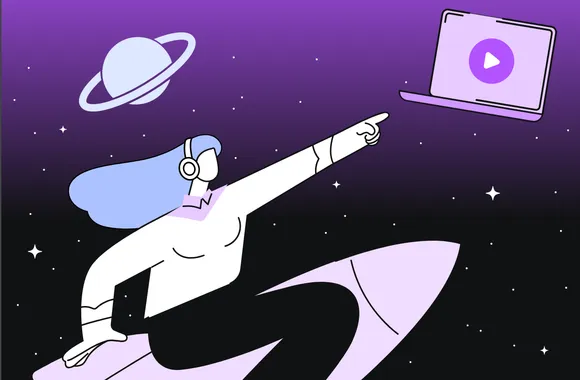Video is more popular online than ever. Users love this kind of content, so brands and marketers are responding with more video than ever, especially buzzfeed videos as well as testimonial videos.
That’s a good thing, because video is a powerful way to build connections and educate users on your product. But it also means there’s lots of competition — if your video is blurry, dark, or low-quality, your customers will probably just scroll on by.
But don’t worry — there’s no need to shell out for a video agency or professional camera gear. There are plenty of simple, accessible ways that any marketer can create a video that looks a lot more professional, at both the shooting and editing stages.
Keep reading, and we’ll tell you everything you need to know about how to create a video that looks super professional, whether it’s for Youtube social media, or somewhere else entirely!
6 steps to shooting a professional-looking video
To create a professional finished video, you need to start with great raw material — your video footage!
Follow these steps before you start shooting, and you’ll be rewarded with a much clearer, more engaging high quality video.
1. Write a good script
- Why? If you expect people to listen, you need to know what you’re going to say! Preparing a video script will help you deliver a clear message. That’s why we suggest writing one even for shorter videos,
- How? If you aren’t sure what makes for a good script, try reading it out loud before you start filming. Can you speak naturally, without stumbling over your words or feeling awkward?
2. Polish your intro
- Why? If there’s any part of your video that you should spend time on, it’s the beginning. If you don’t grab people's attention immediately, they won’t keep watching. So right away, tell them what they’ll get out of watching your video.
- How? Make sure you’re promising value, especially if you can phrase it in a hooky or intriguing way (think “what people get wrong about video intros,” not “video intro tips”). Also be sure to open on a compelling frame, especially one that includes a person. Also, keep in mind to follow the rules of personalized video marketing! Feel free to check our online free intro maker and create hooky intros.
3. Use good lighting
- Why? If your audience can’t see you clearly, there’s no reason for them to keep watching. Good lighting helps you highlight the key elements of your video and keep users’ attention where you want it.a
- How? Natural light can work perfectly well, if you can film at the right time of day in a room with as many windows as possible. You can also invest in a studio lighting setup, and there’s no need to spend a lot to get great results. Choose from 2- and 3-point lighting setups depending on your needs.
4. Use a clean background
- Why? Along with good lighting, a distraction-free background will help audiences focus on the content of your video. So get that clutter out of the way!
- How? Choose a clear location to film, where you have plenty of space to move around. Make sure to tidy up and get unnecessary objects out of the camera’s view.
5. Use a tripod
- Why? You need a tripod to make sure your image is stable, and your subject isn’t shaking around in the frame. Otherwise, your video will be confusing and annoying for viewers to watch.
- How? Attach your phone to the tripod, then experiment to see how far it should be placed from the person you’re filming. If you’re filming yourself, you’ll also need a remote shutter (or your camera’s timer) so that you don’t have to sit within reaching distance of your phone.

Wondering how much a corporate video costs ?
6. Prepare your tech setup — ahead of time
- Why? Make sure that by the time you’re ready to shoot, you have your whole technical setup ready to go. With all the time you’ll spend on filming, you don’t want to find out that one little thing is off and have to start again.
- How? Do as much of your prep work as you can before shooting day. Then when you’re ready to shoot, make sure you start early enough that you can do a test run or two.
Are you looking for a professional corporate video maker? Discover the power of PlayPlay and create captivating videos that engage your audience, all with a few simple clicks!
6 tips to make your videos look professional in editing
Once your video content is ready to go, you can use your editing process to make your video clips even more clear, entertaining, and attention-getting. Here are some editing tips to keep in mind so that your video looks as professional as possible.
1. Choose a good video editing program
- Why? You need a tool that will make editing fast and intuitive, even for beginners, but still give you the results you want. Most marketers don’t have the time, skill, or budget for editing software like Adobe Premiere Pro or Final Cut Pro.
- How? Look for an easy to use editing tool designed for marketers. The right option will have plenty of drag-and-drop templates for different marketing needs. PlayPlay is one video maker designed specifically for the needs of in-house marketing teams!
2. Add subtitles
- Why? Subtitles make videos more accessible. Users don’t need the sound effects to get your message, whether they’re browsing on mute or they’re hearing-impaired.
- How? To really make things easier on yourself, choose a video editing software with automatic subtitling (like PlayPlay)! Otherwise, you’ll end up spending hours on captioning whenever you want to post a video.
3. Use motion graphics and motion transitions
- Why? Fun, moving video effects are one of the best ways out there to add visual interest to your video. Graphics make your video dynamic and keep viewers’ eyes on the screen. Effects, such as splicing together video clips in engaging transitions, can stop things from getting boring, too.
- How? Have fun with the animations, but don’t go crazy. Don’t use too many effects, and try to keep them cohesive with each other.
4. Add music to enhance your message
- Why? Music is a powerful way to set the mood and up your video’s storytelling power. It can heighten your video’s emotional impact and create more of an experience for users.
- How? First of all, make sure you have permission to use the music — there are plenty of places to find great, royalty-free music online. You’ll also make sure the music complements your message, instead of overtaking it. For example, if your video features someone talking, the music needs to be quiet enough that they can still be easily heard.
- Why? Sometimes, you might need to add extra pictures and videos to better illustrate what you’re saying — especially if you’re explaining a complicated or abstract concept. But make sure you choose high-quality stock media or you risk bringing your whole video down.
- How? There are many online resources for great-looking, royalty-free pictures and video. Some video creation platforms, like PlayPlay, even come with a stock library built in!
6. Polish your outro and end with a CTA
- Why? If your intro is all about grabbing the viewer’s attention, then the outro is about telling them where to direct it next. If you’re not ending with a clear call to action, you’ve missed a golden opportunity!
- How? Always use your outro to establish a clear connection to your brand and and give viewers a clear next step. Feel free to try out our online free outro maker !

You need some video ideas?
Whenever creating content, you should bear in mind one golden rule: quality over quantity! This allows you at the same time to repurpose video content through various channels and formats as it's valuable to your audience. A case study video highlighting the context of implementation of your product could be for example also converted into a short how-to video, given that your customer explains how to use a particular feature.
Don’t forget to think out of the box! Video prospecting may sound at first a little bit strange, but can be impactful to help you stand out from all the other commercial mails your prospect gets.
It’s video time!
As you can see, there’s no need to spend a load of money or time trying to make professional marketing videos. Why not start with your creating you own videos, maybe a video slideshow of the last quarter highlights. By following these simple rules while you’re setting up, filming, and editing, you can create videos that speak clearly, represent your brand, and pull your viewers — and customers — in. Get your video strategy started with PlayPlay, the video creation platform! Convince yourself during your 7-day free trial period.
Melissa Francois
Head of Global Content & Comms
With over 10 years of experience in the wild world of SaaS, Melissa cares about building great brand stories and driving community engagement through engaging content. Off the clock, she enjoys long walks and a pint in a cozy country pub.



